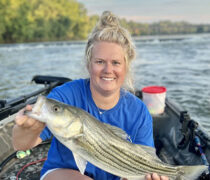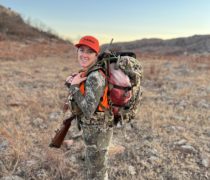Dall Sheep Hunt – Alaska

By Jodee Dixon, Artemis Ambassador – Alaska
I started writing this on Mother’s Day. My feathers are a little ruffled after reading how, in the past, it seemed most mothers support their spouses and children on their hunting trips, rather than going out with them. This, on the tail of a virtual meeting with 30 Artemis Ambassadors, all keen hunters, and none with women as their primary role model for hunting.
Perhaps one way I can contribute, is to be a mentor. Not an expert or a guide, but a woman willing to share my time and what I’ve learned in my adventures.
Dall Sheep Hunt 2017, Alaska. My husband, Shane and I fly in for my 4th sheep hunt – his 20th. The first 5 days are spent thoroughly checking out the areas within a days’ hike from our tent. A few rams are spotted way off in the distance, but cliffs, canyons and glaciers block any thought of approaching them.
We study the map, weigh our options, and make a decision to move camp into another valley.
Day 6 starts early with a 3000-foot climb up a steep scree slope to a saddle on a ridgetop. Nerves are strung tight with the unknown. We get to the top and see descending is possible into the new valley. Another steep scree slope leads down to a glacier for a 3-hour hike on ice. We finally step off the last of the ice as daylight fades. A flat, sandy area makes a luxurious camping spot.
Day 7, after a long day yesterday, a slower breakfast is enjoyed with thorough glassing in the new terrain. The glassing is important:
Glassing with binoculars or a spotting scope is done to locate sheep far away. As we get closer, we are can assess whether the rams are legal. Hunting regulations in Alaska require a full curl ram, double broom, or 8-year-old or older to be a legal harvest. There are rings on the horns that are counted to age a ram. Counting these at a distance is tricky; it can be subjective even when the horns are in hand. If they are broomed, it can be quite obvious as it means more than the lamb tip is broken off, but that is rare. Confirming a legal ram isn’t easy, they don’t exactly stand still giving us a perfect side view. Hence, the time required to glass.
We don’t see any rams and slowly move camp down the valley. Knowing sheep have such good eyesight means that we must go slowly and be diligent observing the terrain ahead. We spot a band of rams on river right. We can see horns at this distance but are not nearly close enough to assess if any are legal. We hit the sack full of excitement for the next day’s potential.
Day 8, I peek outside the tent at 4:30 am. The moon has lit up a dramatic ridge behind us, & I feel deep gratitude for this experience. As we pack up camp, the dusky light is growing enough that we can begin walking tentatively. In less than an hour of hiking, I see a flash of white out of the corner of my eye. I pat Shane’s leg and give him hand signals that I saw sheep. I have no idea if they were rams, yet.
As we walk to the edge of a boulder field, a band of 4 rams comes into view. We settle down to glass, I prepare my rifle and shooting position. We need more light to assess if there is a legal ram (and whether to shoot). As daylight grows, so does our confidence that we have at least one legal ram! They are overlapping each other, so I wait for a clear shot. As soon as my “shooter” steps clear of the other rams, I squeeze the trigger.
They all run!
Shane anxiously asks, “Did you hit him?”
Defensively I state, “Yes! It felt like a great shot, good rest, I’m sure I hit him just behind the shoulder.”
We separate about a hundred yards apart and slowly walk in the direction that the sheep had run. I quickly find my ram piled up in a shallow, rocky ravine.

Double lung shot! This usually means that they can run for a short distance and it minimizes the amount of meat damage. The work of field dressing begins. We skin the ram, cut all the meat off the bones, and pack it away in meat bags. Heart and liver go in a plastic bag after cooling on a rock. Field dressing is a lot of work. We take breaks as well as take turns with the bone saw cutting off the horns – which are required to be brought to ADF&G for sealing. Packs now heavier, we head to the creek and get ready to hunt a ram for Shane on the other side of the valley.
Shane’s ram was down by noon.
Both our packs fully loaded, and still in new territory, we head down stream.
There is familiar territory downstream, but it is a long ways away and through a canyon. The side slopes have many gullies with loose scree. Walking out the creek bottom is the best choice, even though it means crossing back and forth through the water. We have ‘Wiggies’ which are loose, waterproof leg waders that we use to cross creeks. Like most lightweight gear, the Wiggies have some wear & tear and aren’t 100% waterproof anymore. We hike, take breaks, eat, drink, pee, and cross the creek many, many times. My pack is just over 100 lbs. and Shane’s is likely 140 lbs. The victorious day drags on and becomes an extreme mental and physical challenge.

“F*** the Wiggies, my feet are already wet, I’m walking through the creek from here on out!” I state, well maybe yell, to Shane and the canyon walls. Like I’m going to offend the canyon or the creek! Soaking wet feet with a heavy pack is asking for problems, but I do it anyway. Daylight fading, fatigued and waves of bad attitude have come. “Why can’t I be a girl for once, cry, and have someone carry my pack?” This thought is said loudly in my head. I’m embarrassed that the negative stereotype of girls being weak is in my mind. I was not being weak, I was struggling. We were both maxed out! Everyone has an end to their endurance. I focused on a mantra “I can do this!”
Past midnight, the joy and second wind hit me as I recognized the ‘last corner’ of the canyon. A camp spot was getting really close. Finally, we arrive, off with the packs, on with the stove and eating of the food. We hang the meat bags as best we can, off little shrubs on the river bank, and set up camp. Shane and I efficiently flow between tasks, setting up the tent, blowing up the sleeping pads, and laying wet boots and pants to air out. These experiences unite us. I barely remember vacations to Hawaii, but I remember our hunts.
Day 9, we sleep until the daylight wakes us in the tent. I love the surprise view from the tent first thing in the morning! I see a band of sheep across the valley. Shane thinks I’m joking! We enjoy the irony, the view and eat as much food from our pack as we can to lighten the load.
We have a ½ day hike to a pick-up location. I put dry socks on, then plastic bags, then stuff my feet into my boots and lace them up tight. Heavy packs on, waist belts, shoulder straps and chest straps are all cinched up tight onto the tender spots of our bodies. Deep breath, I can do this.
There are very few rest spots along the way. Big boulders are the best place to lean the weight of the pack onto. Anything else is just too hard to either sit down or get back up. My mantra continues; ‘I can do this’.
We get to the little strip where the plane can land. Packs down and a wave of satisfaction, confidence, achievement and relief wash over me.
I had doubts. That showed me I was pushing myself. Without that push, I’d have little to write about, little memory of the entire experience. I wouldn’t change a thing.
Shane messaged the pilot and within the hour, our ride is there. I did have a proud little smile when the pilot, a man who knew these mountains, and a man of few words said, ‘so, you took the scenic route?’.






